On this page:
The New Golden Bell Mine, or simply the "Bell mine," was located about 3/4 mile southwest from the Rosedale mine. There is little
to see at the site today. The Bell mine and mill was the 2nd largest gold producer in the Rosedale Mining
District. The original mining claim was filed by L. M. Lasley in 1895 and described as located at sec.12 T.6S R.6W.
By 1895,
the gold profits of the Rosedale mine was becoming legendary, bringing many prospectors and investors to Rosedale to stake their own
claims. Some even compared the area to another "Cripple Creek," referring to the lucrative Colorado mining area.
L. M. Lasley, a merchant from San Marcial, was one such prospector. His claim appears to be on the same rhyolite ridge and vein
as the Rosedale mine, or one parallel to it. Lasley spent a fair amount of money developing the property with an adit and shaft
to access the vein.
There are no known company records to indicate the amount of gold ore shipped or profits realized
during this period. Newspaper articles in 18981900 newspapers report gold ore was being shipped to smelters
in Colorado from the railhead at Magdalena. In November 1900, the Socorro Chieftain newspaper reported ore taken from the 9th
level of the mine was yielding a fairly respectable return of over $500 per ton.
Mine Sale. Lasley sold
the Bell mine in 1901 to three individuals, though "retains an interest in the property" in effect bringing on three partners. TheSanta Fe New Mexican was the first to report the sale on May 10, 1901:
33.8019°N, -107.4194° Elev. 7,438 ft. ASL
Building an Ore Mill. In mid-1903, the owners decided to follow the lead of the Rosedale mine and build their own mill
to increase profits. Shipping and smelting raw ore from the mine was expensive with a smaller yield per ton. By milling
on-site, much richer ore is delivered to the smelter for processing into gold bullion at higher yields per ton, reduced costs,
and yielding higher profits.
The arrival of the mill machinery by rail to San Marcial made big news in the Feb. 15, 1904Santa Fe New Mexican:
The article is in error, only in that two of the new partners, brothers Samuel G. and William J. Hanna, do not live in the east, but
well established local business-men. The brothers operate the S.G. Hanna grocery and hardware store in San Marcial.
In
August 1901, the Socorro Chieftain reports the new Hanna Bell mine is working in fine ore and now shipping nearly daily to
the railroad terminal at San Marcial instead of Magdalena, enroute to the smelters in El Paso for smelting into gold bullion.
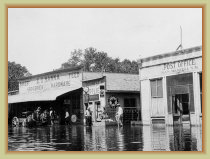
Photo: SCHS Archives
The S.G. Hanna store in San
Marcial after the 1929 flood, two
years after Hanna's Bell Mine
in Rosedale closed.
The Golden Bell Mill. Unlike the Rosedale mine using stamp mills, the Bell mine elected to use the relatively new
Lane slow
speed roller mill for crushing the ore. Made by the C.C. Lane Co. in Los Angeles, large crushing wheels slowly turned to crush the
ore to recover the gold concentrate.
The Bell Mill went into operation late 1904 processing 4050 tons of ore per day from the
mine. Period newspapers report the success of the Bell mine and mill, implying nearly continuous operation, though no
specific
details of tonnages shipped or value of the recovered gold are given.
By 1909, it is reported that Charles Capsul
is the new mine manager and D.M. Farson of Chicago the principal owner, indicating a change in partnership and management. The
Hanna brothers in San Marcial remain as partners. Also in 1909, the mine reports ongoing assessment work in new drifts, and
a 300-yard tunnel has been completed that connects with an old tunnel through a shaft (winze) to access more of the vein.
The
Bell mine continued to be a lucrative mine and the second leading producer of gold in the Rosedale mining district. However,
by around 1915, it appears the gold ore was playing out and the output of the mine and mill was on a decline.
Mine Sale.
In 1917, it was reported in the Socorro Chieftain that James Porters and W.T. McCaskey of Lordsburg had taken over the Bell mine.
It appears the San Marcial Hanna brothers remained as partners, or at least significant investors. The mine was described as
the main shaft now 430 feet deep with nearly 5,000 feet of drifts and cross-cuts. The vein was described as being nearly vertical
and 5 to 14 inches in width very similar to the Rosedale mine.
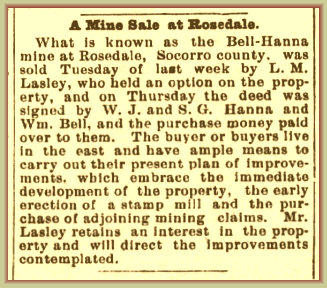
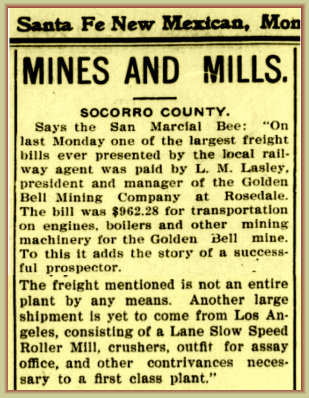
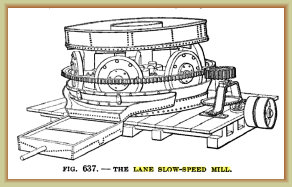
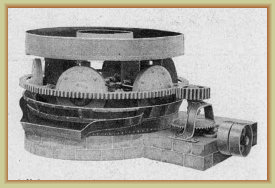
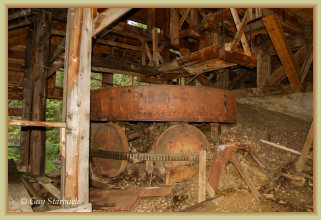
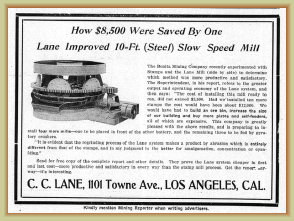
The C.C. Lane slow speed roller mill was 10-feet in diameter and consisted of six crushing wheels. Raw ore is fed at the top onto
a circular table on which the crushing wheels rotated at eight revolution per minute to crush the ore very similar to
a flour grist mill. The advantage of this mill over a ball mill or stamp mill was it could be powered with an 810 horse power engine.
When introduced in the early 1900s, the power source could be a small gasoline
combustion engine rather than a large, expensive boiler
and steam plant common in most mills. One mill processed about 4050 tons of ore per day, crushing the ore to quarter-inch pieces
making it easier to separate the gold concentrate from the ore tailings.
Illustration of the Lane roller mill.
Catalog photograph of the Lane roller mill.
Photo: Guy Starbuck, Starbuck's Exploring
A Lane roller mill in an abandoned mill ruins in Montana used for crushing copper ore.
Photo: Mining Reporter, 1907
A 1907 advertisement for the C.C. Lane Co. and their slow speed mill.
The Last Days. In late 1917, it was reported gold shipments to the El Paso ASARCO smelter were yielding an average of $20 per ton,
far less than the $50100 per ton yields from earlier years. In the mining industry, $12 per ton was considered the minimum yield
to sustain operations. Thus, the ore from the Bell mine was approaching the zero-profit point.
In 1919, it was reported the Bell
mine and mill was now idle, like most of the other mines and prospects in the Rosedale region. The accessible gold ore was simply
becoming exhausted. The Rosedale mine produced on a limited basis primarily because they hit water at 730 feet deep in the shaft,
preventing the relatively rich gold vein from being worked any deeper. The Golden Bell main shaft, following the vein, had reached
a depth of about 500 feet when the mine went idle. It is possible they, too, struck water and were unable to work the vein any
deeper, though no documentation exists as to why the Bell mine went idle.
The 1920s marked the end of the Rosedale mining district.
Most mines in the region were now closed or idle. Even the Rosedale mine continued only with a skeleton crew. The furloughed
workers moved from Rosedale to find employment elsewhere leaving only a few hearty souls and a handful of miners left living in the
town. Of course, mining was on a decline through the western states. Mining jobs were getting scarce, forcing many miners
to seek employment in other than the mining industry.
There are no newspaper reports of any activity at the Bell mine from
1920 until 1927. In that year, some low level mining was reported. The last documented shipment of ore was in late 1927
when the mine was closed.
In 1929, a
devastating flood roared down the Rio Grande. The Santa Fe Railroad
and the entire business district at San Marcial were destroyed and the town abandoned. [More information and photos on the
1929 San Marcial flood
here].
There are reports of some development work at the Bell mine in 1929, though no reports of
any meaningful mining activity or ore shipments. It is possible the remaining owners of the property, the San Marcial brothers
of Samuel and William Hanna, attempted to reopen the mine. Loosing their San Marcial business, homes and livelihoods in
the flood, likely they made an attempt to reopen their mine to make a living. Whether due to lack of financing, access
to only low grade ore, mill machinery not working or previously disposed of, or other difficulties, the 1929 efforts produced no paying
ore. Furthermore, the ore shipping facilities at San Marcial were destroyed in the flood, making shipping ore to the smelters
very difficult and expensive. There are no mentions of any activity at the Golden Bell mine after 1929.
Links:
Socorro County Historical Society
Socorro, New Mexico, USA
History
Articles
Rosedale and the Rosedale Mines
Mines3
4
Rosedale Area Mines
Click on mine name for more information
Mines3
19/0615






